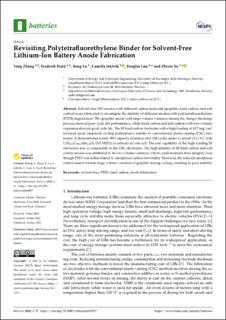| dc.contributor.author | Zhang, Yang | |
| dc.contributor.author | Huld, Frederik | |
| dc.contributor.author | Lu, Song | |
| dc.contributor.author | Jektvik, Camilla | |
| dc.contributor.author | Lou, Fenliu | |
| dc.contributor.author | Yu, Zhixin | |
| dc.date.accessioned | 2023-02-17T14:15:21Z | |
| dc.date.available | 2023-02-17T14:15:21Z | |
| dc.date.created | 2022-07-04T10:24:57Z | |
| dc.date.issued | 2022 | |
| dc.identifier.citation | Zhang, Y., Huld, F., Lu, S., Jektvik, C., Lou, F., & Yu, Z. (2022). Revisiting Polytetrafluorethylene Binder for Solvent-Free Lithium-Ion Battery Anode Fabrication. Batteries, 8(6), 57. | en_US |
| dc.identifier.issn | 2313-0105 | |
| dc.identifier.uri | https://hdl.handle.net/11250/3052033 | |
| dc.description.abstract | Solvent-free (SF) anodes with different carbon materials (graphite, hard carbon, and soft carbon) were fabricated to investigate the stability of different anodes with polytetrafluorethylene (PTFE) degradation. The graphite anode with large volume variation during the charge/discharge process showed poor cycle life performance, while hard carbon and soft carbon with low-volume expansion showed good cycle life. The SF hard carbon electrodes with a high loading of 10.7 mg/cm2 revealed good long-term cycling performance similar to conventional slurry-casting (CSC) electrodes. It demonstrated nearly 90% capacity retention after 120 cycles under a current of 1/3 C with LiNi0.5Co0.2Mn0.3O2 (NCM523) as cathode in coin cell. The rate capability of the high-loading SF electrodes also is comparable to the CSC electrodes. The high stability of SF hard carbon and soft carbon anodes was attributed to its low-volume variation, which could maintain their integrity even though PTFE was defluorinated to amorphous carbon irreversibly. However, the reduced amorphous carbon cannot tolerate huge volume variation of graphite during cycling, resulting in poor stability. | en_US |
| dc.language.iso | eng | en_US |
| dc.publisher | MDPI | en_US |
| dc.rights | Navngivelse 4.0 Internasjonal | * |
| dc.rights.uri | http://creativecommons.org/licenses/by/4.0/deed.no | * |
| dc.title | Revisiting Polytetrafluorethylene Binder for Solvent-Free Lithium-Ion Battery Anode Fabrication | en_US |
| dc.title.alternative | Revisiting Polytetrafluorethylene Binder for Solvent-Free Lithium-Ion Battery Anode Fabrication | en_US |
| dc.type | Peer reviewed | en_US |
| dc.type | Journal article | en_US |
| dc.description.version | publishedVersion | en_US |
| dc.rights.holder | The authors | en_US |
| dc.subject.nsi | VDP::Teknologi: 500 | en_US |
| dc.source.pagenumber | 13 | en_US |
| dc.source.volume | 8 | en_US |
| dc.source.journal | Batteries | en_US |
| dc.source.issue | 6 | en_US |
| dc.identifier.doi | 10.3390/batteries8060057 | |
| dc.identifier.cristin | 2036971 | |
| dc.relation.project | Norges forskningsråd: 310353 | en_US |
| cristin.ispublished | true | |
| cristin.fulltext | original | |
| cristin.qualitycode | 1 | |

